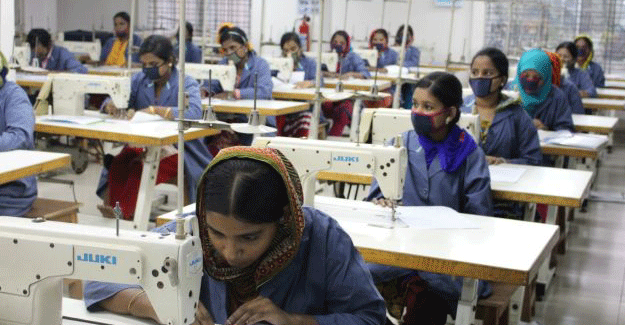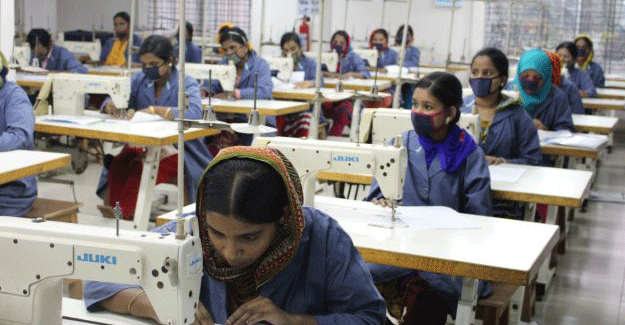
Garment Sourcing Practices Violate Supply Chain Compliances, Shows Study
Apparel suppliers are being forced to comply with and follow social and environmental standards set forth by their international buyers, and various agencies. In Bangladesh, retailers have worked closely for five years with garment manufacturers, to upgrade safety standards, and to ensure that workers are no longer exploited.
One would assume that with all the standards, certifications, and higher wages, Bangladeshi garment exporters would have to increase their garment prices for the buyers.
However, unit realisations have come down significantly over the years following the Rana Plaza disaster in 2013. A study by Penn State University's Center for Global Workers' Rights found ahead of the fifth anniversary of the Rana Plaza disaster that brands are generally paying less for garments today.
The study - Binding Power: The Sourcing Squeeze, Workers' Rights, and Building Safety in Bangladesh Since Rana Plaza - was carried out by Mark Anner, director of CGWR.
The report looks at Bangladesh's top exports to the United States and to the European Union in comparative perspective.Bangladesh's top export to the United States is men's and boy's cotton trousers.
According to Anner, "If we look at the top apparel exporting countries to the United States, and we take price paid per square meter in real dollars (that is, controlling for inflation), we see two trends.
First, in general, the price point comes down. Second, Bangladesh comes down to the lowest level. A similar dynamic can be observed with respect to t-shirts."
T-shirts account for the largest percentage of garment exports from Bangladesh to Europe (EU-28).
In 2016, Bangladesh exported more than 250 million kilograms of t-shirts, far exceeding the combined amount of t-shirt exports from the second, third, and fourth top exporters (China, India, and Turkey). It did this by providing the lowest price point.
And, overall, a real dollar price decline is noticed. During this period, the average nominal euro-per-kilogram price of imported t-shirts into EU-28 countries dropped from EUR 11.21 to EUR 10.63.
A look at the nominal prices paid since Rana Plaza for trousers exported to the United States, shows a 13% decline. This is the result of a price squeeze by lead firms.
Alternative arguments would be that the decline in price is the result of exchange rate fluctuations or the price of cotton. But this is not the case here.
Regarding exchange rates, between 2013 and 2017, the rate of devaluation was only 3.8%.
And the local (Taka) component is only a small fraction of total costs, making the impact of exchange rate fluctuation less than 1% of the variation in price.
Cotton prices, while declining between 2013 and 2015, rose by 22.13% between 2015 and 2017. During this same two-year period in which cotton prices increased, prices paid for imported trousers declined by 11.48%. Hence, the decline in the price of imported trousers is clearly not the result of declining cotton prices.
Supplier Survey in Bangladesh
To get a better sense of the buyer-supplier relationship, researchers conducted a survey of supplier factories in Bangladesh between March 2016 and March 2017. According to Anner, "This survey was an extremely time-consuming task. After 12 months of efforts, we completed 223 surveys."
The main goal of this survey was to examine sourcing dynamics. This includes pricing, lead times, and payment schemes. The question sought to be answered was whether there was evidence of a sourcing squeeze (declining prices and shorter lead times), or whether buyers were improving the terms of their contracts with their Bangladeshi suppliers.
What the survey results indicate is that the average FOB price was US$ 4.64 in 2016, which is a 7.79% decline from a FOB price point of US$ 5.03 in 2011. For exports to the United States, the price point declined by 10.67%. For European buyers, the price point came down by 9.04%. Indeed, in all major product categories there was a decline in nominal prices paid per unit, the study found.
Profits, Lead Times, Payments, and Order Specifications
If production costs are going up while prices are going down, one way supplier factories can stay in business is to reduce profit margins. The Supplier Survey provides support for this dynamic.
According to the survey results, profit margins decreased by 13.3% from 2011 to 2016, with a mean 2016 profit margin of 7.69%. Retailers are looking for greater speed to market. This allows them to more effectively manage inventory, which then results in a reduced need for discount products and thus greater revenue.
While there may be many inefficiencies along the entire supply chain, including getting products from incountry ports to retailers' shelves, often the supplier factories are the ones who face the greatest pressure to contribute to a retailer's desire for speed to market.
When lead times are adjusted on short notice, this can put considerable pressure on a supplier's business operation and may result in forced overtime or unauthorised sub-contracting. What the Sourcing Survey findings indicate is a reduction, since 2011, in lead times of 8.14%, from 93.4 days to 85.83 days.
Sourcing Squeeze, Wages, and Workers' Rights
Bangladesh pays the lowest wages among major apparel exporting countries. Prior to the Rana Plaza disaster, the monthly minimum wage stood at Taka 3,000 per month (USD 39). Following Rana Plaza, the minimum wages increased to Taka 5,300, which was US$ 68 per month at the 2013 exchange rate.
According to ILO data for January 2015, Bangladesh's minimum wages stood as the lowest among the 10 top garment exporting countries. By February 2018, with the devaluation of the currency, the minimum wage stood at US$ 63.60 per month, a 6.47% decline since 2013.
Given that the normal work week in Bangladesh is 48 hours, and with 4.3 weeks in an average month, this means that the hourly minimum wage in February 2018 stood at 31 cents per hour.
In the case of Bangladesh, prevailing wages only cover an estimated 14% of living expenses, which is the lowest level among major apparel exporting countries (WRC 2013).
In sum, the pricing squeeze has resulted in persistently low wages that do not cover living needs.
This observation leads directly to the question of unionisation rates and the ability of labour to bargain for higher wages.
Bangladesh has been repeatedly notified by the International Labour Organization that laws regarding freedom of association need to come into compliance with international standards, notably by allowing for unionisation in export processing zones and facilitating the unionisation process in the RMG sector by removing bureaucratic obstacles, government discretionary authority, and an unreasonably high 30% membership threshold requirement.
These issues with the labour law are compounded by violations in practice. In December 2016, some 1,600 garment workers were dismissed and 34 trade unionists were arrested and detained following demonstrations in the Dhaka region of Ashulia.
In the aftermath, pressure by national and international labour rights advocates escalated, demanding the government release the detained workers and demanding that buyers put pressure on the government and on suppliers to respect workers' rights.
As a result, several major brands announced that they would limit their participation in the February 2017 Dhaka Apparel Summit to observer status, stating that they were protesting the treatment of workers and trade unionists.
Following Rana Plaza, strong international pressure contributed to labour law reforms that modestly facilitated union registration, while leaving in place a 30% threshold for unionisation formation and the continued exemption of Export Processing Zones from the labour law.
As of January 2018, there were 440 RMG factories with unionisation, up from less than 100 prior to Rana Plaza. However, the growth in union formation has not been maintained due to the increased tendency of the Bangladesh government to deny union registration and continued anti-union practices by employers.
To understand worker rights dynamics, it is also useful to examine the influence of pricing and other sourcing practices.
Anner states, "Using a newly released dataset hosted by the Center for Global Workers' Rights, the Labour Rights Indicators (LRI), we are able to observe three trends over time.
In general, since 2000, there has been an overall increase in the violation of workers' rights. These violations continued to increase following Rana Plaza. To explore the relationship between workers' rights and pricing, we can superimpose the real dollar price per square meter for men's and boy's cotton trousers exported to the United States on the graph of workers' rights in practice based on LRI data.
"During the first periods when prices declined, 2000-2005, violations of rights increased. Then, from 2005 to 2009, export prices to the United States leveled off and violations decreased. Prices increased from 2009 to 2012. From 2012 to 2015, prices declined yet again, and violations rose."

Textile Excellence
If you wish to Subscribe to Textile Excellence Print Edition, kindly fill in the below form and we shall get back to you with details.








